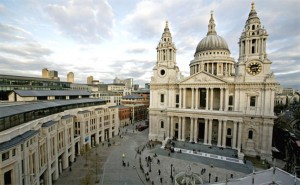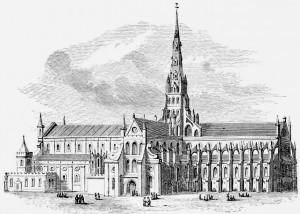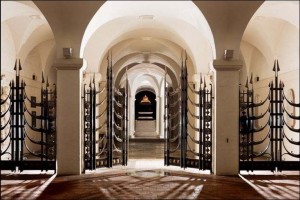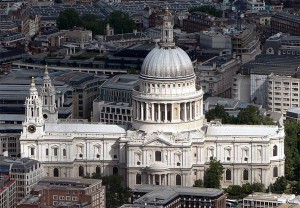How was St. Paul’s Cathedral Built
London’s crowning glory, St Paul’s stands as a monument to one man’s genius.
Sir Christopher Wren produced three designs for his new cathedral. The first two were rejected and the cathedral as built only bears a small resemblance to the third.
Built mainly of Portland stone, St Paul’s contains many idiosyncrasies – two of the most familiar features, for example, are misleading. The outer walls are built in two distinct storeys, but the upper storey is false, it simply acts as a screen to hide the flying buttresses that support the high vaults. On the other hand, the iconic dome -which crowns the outside of the cathedral – is not the one inside; the interior dome is positioned much lower for aesthetic effect.
 Wren gathered leading artists and craftsmen to work on the building. Perhaps the best known today are Grinling Gibbons, responsible for the woodwork; Francis Bird, who sculpted the great west pediment; and Sir James Thornhill, who painted the life of St Paul on the interior of the dome. Taking Just 35 years to complete, the interior is much as Wren left it; the Victorians added some stained glass windows and mosaic decoration to the roof in the choir and above the main arches of the dome, but they blend well with Wren’s grand conception.
Wren gathered leading artists and craftsmen to work on the building. Perhaps the best known today are Grinling Gibbons, responsible for the woodwork; Francis Bird, who sculpted the great west pediment; and Sir James Thornhill, who painted the life of St Paul on the interior of the dome. Taking Just 35 years to complete, the interior is much as Wren left it; the Victorians added some stained glass windows and mosaic decoration to the roof in the choir and above the main arches of the dome, but they blend well with Wren’s grand conception.
Site history
London’s first cathedral was built in 604, but this building or its successor was burned down in 1087. A great Norman cathedral known as ‘Old St Paul’s‘ was then built on Ludgate Hill. The choir was reconstructed in the 13th Century to provide more space, the total length reaching 178m.
 The spire added to the central tower in 1315 reached 149m; there were also two west towers, two cloisters and a two-storey Chapter House. In the 17th Century, Inigo Jones commissioned to improve the cathedral, refaced the nave and west end in classical style and erected a grand portico. After the Commonwealth, Wren made ready to continue these plans by casing the nave with Renaissance detail and building a dome to replace the tower, but his work was terminated by the Great Fire of 1666.
The spire added to the central tower in 1315 reached 149m; there were also two west towers, two cloisters and a two-storey Chapter House. In the 17th Century, Inigo Jones commissioned to improve the cathedral, refaced the nave and west end in classical style and erected a grand portico. After the Commonwealth, Wren made ready to continue these plans by casing the nave with Renaissance detail and building a dome to replace the tower, but his work was terminated by the Great Fire of 1666.
Wren’s vision
Sir Christopher Wren, as Surveyor to the King’s Works, was responsible for building the new St Paul’s. He had previously designed such well-known buildings as the Sheldonian Theatre in Oxford and the Chapel at Pembroke College, Cambridge. Although now best known as an architect, he was also an astronomer, a scientist and a talented mathematician. While the architectural style and detailing is Renaissance ‘English Baroque’, the basic form and structure of Wren’s St Paul’s mirrors the medieval cathedral, consisting of two western towers, a long nave, a central crossing above which rises a tower (the dome) and choir. St Paul’s the first English cathedral completed in the original architect’s lifetime, which gives it an architectural unity rarely found in earlier gothic churches.
The crypt
 The crypt in St Paul’s mirrors its medieval predecessor, which extended under the east end of the old cathedral. Wren’s crypt, however, with its central cluster of Roman Doric pillars and simple piers below nave and choir, extends below the cathedral’s full length and is the largest in Western Europe. Built using stones salvaged from the ruins of Old St Paul’s, the crypt houses chapels and monuments. At the eastern end of the crypt is the OBE Chapel (Order of the British Empire). There are many notable graves in the crypt including those of Lord Nelson, the Duke of Wellington and Sir Alexander Fleming. Wren’s grave with its famous epitaph is also to be found there: ‘Reader, if you seek his memorial – look around you’.
The crypt in St Paul’s mirrors its medieval predecessor, which extended under the east end of the old cathedral. Wren’s crypt, however, with its central cluster of Roman Doric pillars and simple piers below nave and choir, extends below the cathedral’s full length and is the largest in Western Europe. Built using stones salvaged from the ruins of Old St Paul’s, the crypt houses chapels and monuments. At the eastern end of the crypt is the OBE Chapel (Order of the British Empire). There are many notable graves in the crypt including those of Lord Nelson, the Duke of Wellington and Sir Alexander Fleming. Wren’s grave with its famous epitaph is also to be found there: ‘Reader, if you seek his memorial – look around you’.
Facts about St. Paul’s Cathedral
 Lord Nelson – After Lord Nelson died at the Battle of Trafalgar on 21 October 1805 he was buried in the centre of the crypt directly beneath the crossing and dome.
Lord Nelson – After Lord Nelson died at the Battle of Trafalgar on 21 October 1805 he was buried in the centre of the crypt directly beneath the crossing and dome.
Duke of Wellington – In 1852,1 million people watched the Duke of Wellington’s funeral procession to St Paul’s before he was interred in the crypt in a luxulyanite sarcophagus.
Attempted bombing – In 1913, suffragettes – in an attempt to bring attention to their cause – planted a bomb under the Bishop’s throne in the choir. Luckily, it was defused before it exploded.
Sir Winston Churchill – Sir Winston Churchill’s state funeral at St Paul’s Cathedral on 30 January 1965 was the first to be broadcast to the nation on both radio and television.
The Royal wedding – Charles, Prince of Wales, married Lady Diana Spencer on 29 July 1981 after which St Paul’s became one of the most visited churches in England.

